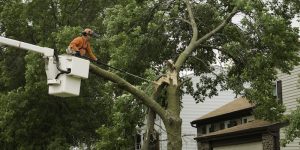How Much Does Emergency Tree Removal Cost?
Sometimes a tree emergency is obvious. A heavy storm or severe weather rolls through your area, leaving a fallen tree or damaged tree limbs in your yard. At other times, however, you might not realize that you have an emergency tree situation on your property.
Perhaps a tree has grown so large that it's leaning toward your house, or some of its branches have overgrown. Even sick trees with peeling or brittle bark, knotty roots, and fungus can pose a danger, as can dead trees. Another strong storm, a gust of wind, or simply gravity can cause a tree in such shape to fall, damaging your home, striking power lines, and causing serious injuries or death. Storm damage is the the most common reason homeowners need emergency tree removal service because under very high winds even a healthy tree can sustain damage.
At Tree Cutting Pros, we make it easy to hire a professional to handle your emergency tree removal. We have a network of tree removal companies that are licensed, bonded, insured, and screened to meet the highest levels of customer service.
Please enter your ZIP Code into the form on our home page to obtain several quotes for tree removal cost and choose a knowledgeable, reliable, and affordable tree removal company near you.
Get Emergency Tree Removal Costs

What Affects the Cost of Emergency Tree Removal?
You can expect to pay an average of about $870 for tree removal services--or an average range of roughly $225 to $3,900. Why such a wide range? Several factors that affect the cost of tree removal include:
- the height of the tree
- the type of tree
- whether the job requires heavy equipment
Just as no two trees are alike, the cost to remove a tree varies depending on the complexity of the job.
Here are a few considerations that affect tree removal prices.
The Size of the Tree
Tree size, both height and circumference of the tree trunk, is a major factor that impacts emergency tree removal cost. By size, we don't mean just the height, either. A professional tree service also gauges a tree's size by its trunk's diameter.
Small Trees
Those trees we call "small" are about 5 feet to 15 feet high tall and have trunks no larger than 6 inches in diameter. The average cost to remove a tree of this size is about $200 to $500.
Some small trees may include:
- Japanese Maple
- Magnolia
- Crepe Myrtle
- Lemon or other citrus trees
- Flowering Dogwood
Medium Tree Removal
A medium tree stands about 15 feet to 25 feet in height and has a trunk roughly 12 to 20 inches in diameter. Average emergency tree removal cost from $500 to $900 for a medium size tree.
Some medium trees include:
- American holly
- Cottonwood
- Cypress
- Date palm
Large Tree Removal
A large tree ranges from about 25 to 60 feet in height and might have a trunk with a diameter of about 30 inches. While tree trimming is less expensive, removal costs run higher, from about $900 to $2,500, because of the larger canopy and amount of timber. A company may quote you a per-foot charge for larger tree services for these large trees such as a 30-foot oak or a pine towering to more than 30 feet tall.
Some large trees include:
- Bald cypress
- Eucalyptus
- Oak
- American elm
- Radiata pine
Extra-Large Trees
Any tree larger than 61 feet qualifies as an extra-large tree. Some types such as eucalyptus can fall under this category because they can grow 80 feet tall or more with tree trunks roughly 30 inches in diameter. Emergency tree removal for a large tree costs $2,500 to more than $4,000. You often need a certified arborist to deal with a larger tree, and they also naturally come with much more dead branches and limbs that require more debris removal.
Some extra-large tree species include:
- Spruce
- Pine tree
- Giant sequoia
- Oak tree
- Mountain ash
- Noble fir
- Sugar gum
The Location of the Tree
If a tree sits on an open part of your property with no fences, gates, or other obstacles nearby, it's much easier (and less costly) to remove. In general, removing a tree from a backyard costs more than one in a front yard because positioning equipment and dragging branches from a backyard takes longer.
Unfortunately, emergency tree removal service often involves something precarious, such as tree branches that are too close to your or your neighbor's roof -- or that have fallen somewhere on the property. Even so, you can save a little money and facilitate the removal by ensuring that the tree service has a clear path to the job. Just removing a fencing panel can save you headaches as well as dollars.
The Type and Condition of the Tree
In addition to height, size, and location, the type and condition of the tree also affect the cost of the job. Each tree has different characteristics that require different strategies and equipment. Some situations call for hand saws, pole saws, tree loppers, axes, hatches, stump grinders, chainsaws, or wood chippers. Others involve winches, blocks, pulleys, slings, carabiners, rope, and a crane or an excavator.
If the entire tree needs to be removed rather than just a large tree limb or two then you also need to think about what to do with the tree stump. Most tree trimmers keep a stump grinder on hand to make sure you don't have a portion of the tree trunk sticking out of your yard, but it will cost you a little bit extra. Aside from the actual tree removal job, if your damaged tree has left significant debris and dead branches it can often overwhelm the tree removal experts vehicle. Debris removal can add to the cost of emergency tree service, especially when dealing with a larger tree.
A palm tree might grow 20 feet higher than an oak tree, but the former has a thinner trunk and fronds at the top, weighing perhaps a total of 2 tons. An oak's long branches and fatter trunk make it weigh about twice that much, making for a more complicated process.
Likewise, a maple tree and a cottonwood both stand about 40 feet, but a maple tree has a single main trunk and small bushy branches, weighing a little over 1 ton. A cottonwood tree has a short, thicker trunk and several leader branches, increasing its weight to about 3 tons -- and the price of removal by about $600.
A sycamore with multiple trunks might weigh about 4 tons altogether, needing a crane and several people with safety lines and other equipment to remove it. Yet if lightning strikes such a sizable tree and splits it in two, that changes the removal strategy, equipment, and personnel.
Who Pays for Emergency Tree Removal Service?
Again, this is not a one-size-fits-all situation. Sometimes your municipality will step in to help with the costs of tree work. For instance, if your tree is close to the curb and has struck power lines or grown near power lines, you can contact your local power company, which might cover the cost. It can help to ask your tree company if the they need to submit documentation on your behalf.
A traditional homeowners insurance policy tends to pay for damages related to common named perils, such as a tree striking your roof during a windstorm. The same goes for a tree that lightning split in your yard.
However, some insurers make a distinction between such emergency tree damage and a tree that falls on your property because of a flood or an earthquake. An additional policy or a rider on your original policy might cover the cost of this.
Homeowners' insurance frequently does not pay to remove a dead tree or a diseased tree if you're proactive. However, because of the potential for injury and property damage, a responsible tree service still might consider this an emergency tree removal situation. You or the tree removal company might need to secure a permit or consult with a certified arborist before the job.
Compare Emergency Tree Removal Prices
Additional Costs
Think of tree removal services in terms of what's above the ground. Many people are surprised to learn that the tree removal service cost often does not include the stump.
Stump Removal
In general, a tree removal service will take the canopy and trunk down to the stump. Stump removal costs extra, which typically is an additional cost of about $315 on average. Some companies charge a price based on the stump's diameter of about $2 to $5 per inch.
Stump grinding breaks down the trunk and roots into smaller pieces. A tree service might charge you the cost of removing the roots as an hourly fee, such as $150 per hour.
Depending on where the tree sat on your property, you might decide to leave the tree stump and landscape around it, forming an attractive yard feature.
Removing the Remaining Wood
Sometimes a tree removal service will offer you two different prices for tree removal, one for trimming and removing everything, and another price for cutting and leaving the wood on-site for you to dispose of yourself.
Unless the tree is diseased or especially large, you might want to use some of the tree's wood for firewood, perhaps in a patio fire pit. If the tree has sat on a property for many years, some homeowners also like to keep a cross-section of the trunk or a branch as part of their decor.
How Tree Cutting Pros Can Help You
Trees are a magnificent part of any landscape. Yet even with proper tree care, sometimes a tree can become dangerous because of its size, its health, or other circumstances.
When people need a tree removed, they often don't know where to turn. At Tree Cutting Pros, we believe that hiring a professional shouldn't be a hassle. We partner with local tree services around the country so that customers easily can find the help they need.
Whether you need to remove a small tree, clear away dead trees, or need assistance with stump grinding or another tree emergency, just enter your ZIP Code on our home page to find information and estimates about local tree services. You can also find someone for preventative maintenance such as tree trimming, branch removal, or log splitting.
Don't let your trees cause you stress. Trust Tree Cutting Pros to compile the top-rated tree services in your area, saving you time on research and money by comparing quotes from multiple providers.


